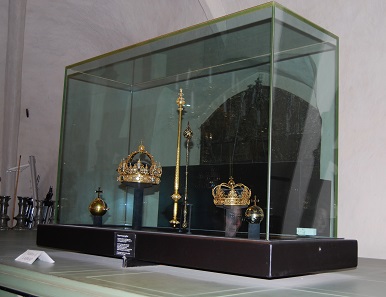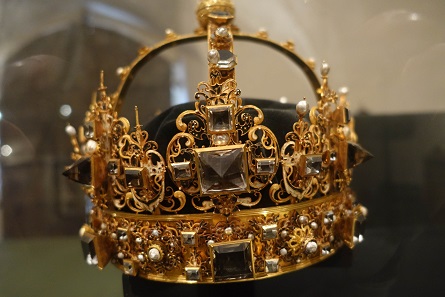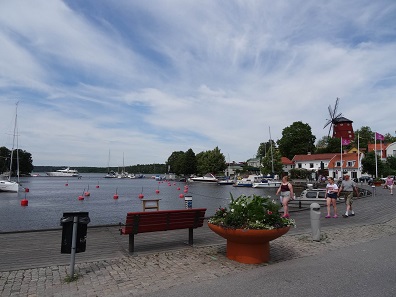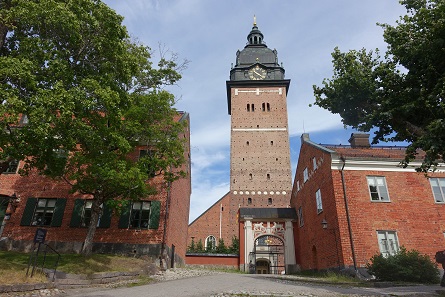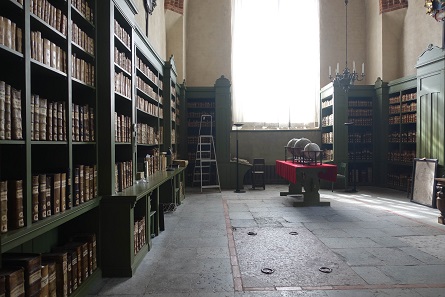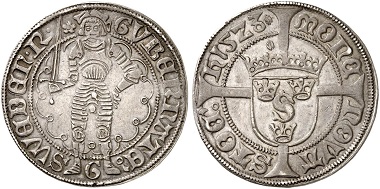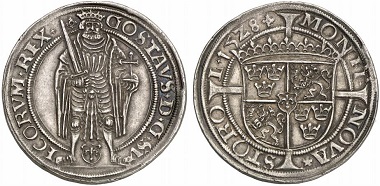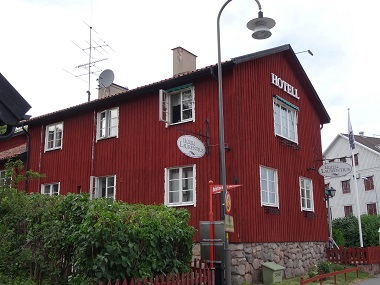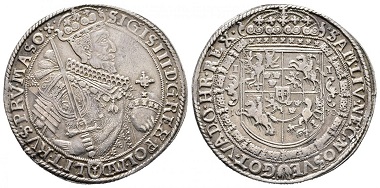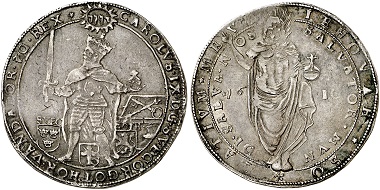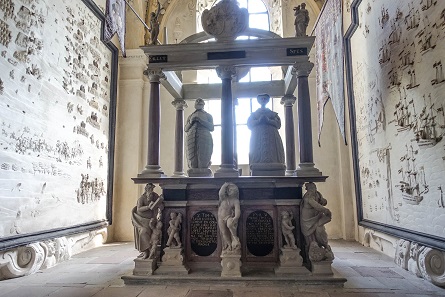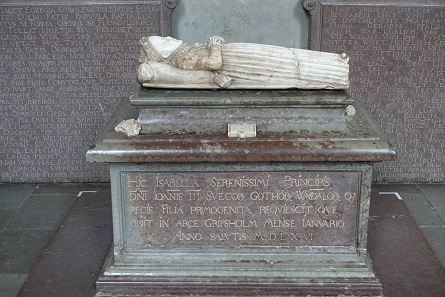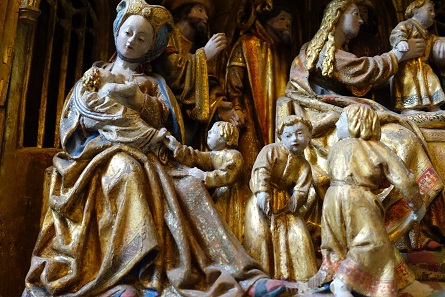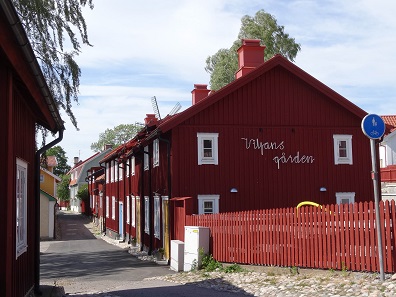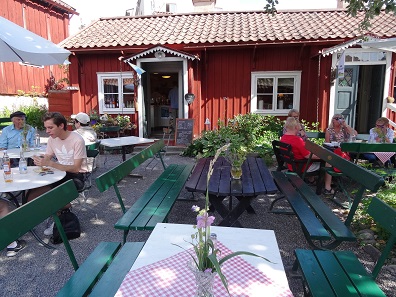Translated by Leonie Schulze
Sweden has a unique and rich history that unfortunately is not very well-known – not just in Germany. We will tell you about it in this series called “Numismatic Miniatures from the North”. In this first part, follow us to Strängnäs, a small provincial town, which made international news at the end of July of 2018. Alas, it was sad news.
The imperial regalia placed in a “safety display cabinet” before the theft. Picture from 2008: UK.
A shameless theft
Two thieves stole parts of the grave goods of Charles IX in Strängnäs Cathedral on July 31, 2018. It did not require much effort. They merely walked into the cathedral, turned left, and walked into a side room, which is not visible from the main nave, where the church treasure is stored. There was no one in the treasure room who could have kept raiding tourists in check. Strängnäs appears to be very accommodating to the behavior of tourists in general. When we visited the cathedral on June 28, 2018, we were quite surprised that the person in charge, who was selling books, cookies, and coffee in the entrance hall, did not even intervene when a child (with the help of its mother) climbed onto the pulpit and yelled at the top of its lungs into the interior of the church. (After all, the reverberation was very impressive!)
Presumably, the thieves went about their business a little quieter until they broke the glass of the safety display case. We do not know for sure what happened then. Did the alarm go off? Or did that only happen when the perpetrators were already on the run? Did the alarm surprise them and that is why they “only” took two crowns and an orb? There was also a scepter and another imperial orb at their disposal. Or were they really only interested in the two crowns and one of the two orbs?
Whatever the case may be, they allegedly used two stolen ladies’ bikes and a boat or a jet ski to escape across Lake Malar. Although the police set in motion a large-scale manhunt immediately, the stolen items have not yet been found.
It should also be mentioned that Dean Christofer Lindgren confirmed that “safekeeping regulations had been followed.” The crowns and the imperial orb were stored “according to the approval and regulations provided by authorities and insurance companies.” Which regulations exactly were complied with was unfortunately not stated in international media coverage.
The crown of Charles IX. Picture: KW.
What is more scandalous than the actual theft, is the unsubstantiated nonsense that the media is spreading about the two crowns and the imperial orb. The German newspaper “Süddeutsche Zeitung”, just to name one particularly stupid example, claimed that the items “had previously been stored in the monarch’s grave”. As the same article also denoted the stolen objects as the crown jewels of the Swedish royal family, experts might find amusement in the mental image of a personal representative of the king descending to the grave of Charles IX before every coronation to take the insignia directly from the tomb to the ceremony, just to take them back afterwards.
All of the articles I read in the daily press were notably ignorant of any information on why these stolen items were of national importance anyway. It might be due to the fact that the source of modern knowledge, Wikipedia, does not have a lot to say about Strängnäs Cathedral. Hence, it would have required someone to take up an old-fashioned book to find out more about Strängnäs, Saint Eskil, the Christianization of Sweden, and its turn to the Reformation. And of course, about why Charles IX was not buried in Uppsala or Stockholm as were his predecessors and descendants, but in Strängnäs of all places.
Today it is a tourist site like many others. Picture: KW.
Present-day Strängnäs
Today, Strängnäs is a beautiful little tourist town with a landing stage for steamers and a small marina. The Swedish syllable “näs” (= nose) describes its location fairly well. The town center is located on a peninsula-like piece of land projecting out into Lake Malar. Said lake is accessible from every part of town. Apart from that, you will find lovely red houses, a vast green landscape, and a gorgeous wind mill, which has turned into a second landmark.
Strängnäs Cathedral. Picture: KW.
Reluctant Vikings and fearless martyrs
There would not be much to say about this place if they had not used its central location to erect an episcopal see at some point in the 12th century. Sweden was Christianized much later than other European countries. The reason why is quite obvious. The belligerent Vikings were faithful to their gods and dedicated one victory after the other to them. Why should they have changed sides from Odin and Thor to the pitiful Christ? They had witnessed all too often that he could not protect his followers who were begging them for mercy.
The library of the cathedral is the town’s pride. Picture: KW.
The people did not take missionaries seriously who came to convert the heathens. Although the king would have liked to ensure the church’s aid in bringing the unruly nobility under control, his subjects just would not get baptized. The English monk Eskil, who had been appointed bishop in the nearby Eskiltuna in the second half of the 11th century, had to accept that, too. His little sheep from Strängnäs stoned him to this because he attempted to prohibit their beloved feast of sacrifice.
The bishopric’s main church in Strängnäs, which was instituted at some point in the 12th century, was supposedly erected at the place of his martyrdom. Today’s cathedral developed from this main church which was probably made from wood at first.
Gustav Wasa holding the title of regent. 1/2 gyllen 1523, Stockholm. From Künker auction 285 (2017), no. 115.
Gustav Wasa celebrating his coronation on January 12, 1528 at Uppsala Cathedral. Gyllen 1528. Stockholm. From Künker auction 196 (2011), no. 5001.
Gustav Wasa: From regent to king in Strängnäs
Ecclesial centers were often used as meeting points in the Middle Ages and the early modern period. The large church buildings were a perfect place of assembly. Therefore, the decisive election which made regent Gustav Wasa the King of Sweden held at the Strängnäs Cathedral during the diet which took place in the town in 1523. Thus, it plays an important role in the national memory of Sweden. Gustav Wasa heralds the beginning of Swedish modern times.
The Laurentius Hotel remembers a famous preacher of Strängnäs Cathedral. Picture: KW.
The Reformation in Sweden
Laurentius Andreae, who had been elected archdeacon of the Diocese of Strängnäs in 1520, was probably present at the election of Gustav Wasa. Andreae sympathized with the ideas of Luther and consequently got along very well with his king. In fact, the Catholic church owned almost a quarter of the entire Swedish territory in 1525 – about as much as the Swedish nobility. In comparison, the king had to cover his expenses with revenues from only 5.5 % of Swedish territory. What would be more obvious than organizing the Catholic church according to the Reformed model and confiscating its property for the crown?
Laurentius Andreae preached that the entire ecclesiastical property belonged to the people (and that the Swedish king would govern it on behalf of his people completely selflessly.) Of course, he also preached other ideas, like those we know from the German Lutherans. Among many other assertions, he claimed the Pope was the Antichrist and he advocated that the true dogma could only be deduced from the Scriptures. Thus, Strängnäs became the center of the new doctrine. From Strängnäs the Reformation spread across all of Sweden.
Sigismund III as King of Sweden. Daler 1597, Stockholm. From Künker auction 27 (2016)- no. 584.
Sigismund III as King of Poland. Reichstaler 1630, Bromberg. From Künker auction eLive 50 (2018), no. 292.
Between Reformation and Counterreformation – between Sweden and Poland
Gustav Wasa’s second-oldest son Johann took over reign in 1568. He was fairly critical of the Reformation. He did not marry a Catholic, the daughter of the Polish king Sigismund I, for nothing. Johann III dreamed of offering the Pope reconciliation as a Protestant. He would find the theological compromise needed to unite the two religions again.
But that was not all. Johann also dreamed of seizing control of the Baltic Sea trade with Russia by uniting Sweden and Poland. Therefore, he had his oldest son Sigismund raised Catholic. The latter could thus take over the Polish throne in 1587. However, when Sigismund Wasa attempted to also take over the Swedish throne after his father passed in 1592, his uncle Charles thwarted his plans.
Charles IX. Riksdaler 1610, Stockholm. The reverse depicting Christ as the Savior is typical of the Protestant reservoir of images. From Künker auction 293 (2017), no. 2159.
Charles IX assumes power in the name of the Reformation
Charles might have been content with just the title of regent in Sweden while Sigismund remained in Poland. But the latter did not want to leave that much influence to his uncle, which resulted in a conflict. Within this conflict, Charles exploited religion. He justified his claim to power by professing he wanted to protect the Protestant legacy of his father, Gustav Wasa.
The bishop of Strängnäs offered crucial help. It comes as no surprise that Charles had chosen him personally; Petrus Jonae Helsingus had already been a decisive opponent of the religious policies of John III.
A combination of military and propagandistic approaches resulted in their success. In 1600, the diet crowned Charles king. The final coronation did not take place until 1607, however.
The grave of Charles IX in Strängnäs. Picture: KW.
Charles’ burial in Strängnäs
On April 21, 1612, Charles IX was buried neither in Stockholm nor in Uppsala, but in Strängnäs Cathedral – according to his will. This was in line with his father Gustav Wasa, who had been proclaimed king here. In his funeral sermon, the bishop of Strängnäs compared Charles to Josiah, King of Judah. Just as the latter had reenacted the rediscovered law of God, Charles was the grand innovator who protected the achievements of the Reformation against papal scheming.
On this occasion, the royal insignia of Charles were taken in possession by Strängnäs Cathedral as a sacred sign of the unity of the ecclesiastical pioneer of Protestant faith and the secular protagonist.
The crown of Queen Christina of Holstein-Gottorp. Picture: KW.
And now both crowns as well as an orb have disappeared. Despite respective police assumptions, it is doubtful that there is an instigator behind all of this. It is much more likely that, once again, some opportunist criminals have speculated on the value of the stuff that was kept in this lousy display case.
The view of the cathedral’s nave. Picture: KW.
What else is there to see at Strängnäs Cathedral?
Although three objects of the cathedral’s treasure might already be in a melting pot, there still remains a lot to marvel at in this church.
The tomb of Charles’ illegitimate son Carl Carlsson Gyllenhielm. Picture: KW.
For example, the grave of the older half-brother of Gustav II Adolph who held the office of imperial admiral during his reign. In this capacity, he achieved countless victories, all of which have been long forgotten. Unforgettable, however, is the sinking of the Wasa. The investigation commission was overseen by Carl Carlsson Gyllenhielm.
The tomb of the little Isabella, daughter of John III and his wife Catherine. Picture: KW.
The tomb of the little Isabella, the oldest daughter of John III, who passed away at the age of two already, undoubtedly is the visitors’ favorite.
This high altar made in Brussels in 1490 is of an impressive quality. Picture: KW.
A detailed view of the side altar. Picture: KW.
Lovers of art will not get enough of the Gothic altars that bishop Kort Rogge bought around 1490 in Brussels with his own money.
The tomb of Hedvig Ulrika Taube. Picture: KW.
The German church guide undermines the importance of an ordinary sarcophagus in one of the first side chapels on the right side. It contains the remains of Hedvig Ulrika, Duchess Taube of Odenkat, who was able to refer to herself as the first acknowledged mistress of the Swedish king. The German house of the dukes of Hessenstein traces back to the sons she had with Frederick I.
Picturesque houses abound in Strängnäs. Picture: KW.
Travel tips:
Strängnäs is the perfect starting point for a ride to Mariefred and Gripsholm, where the prices for rooms are much higher due to the town’s fame resulting from Kurt Tucholsky’s novel.
We stayed at the cozy Laurentius Hotel in Strängnäs. Although it is located at a throughway, the disturbance from traffic noise was minimal. The view of the lake, however, was beautiful!
The Grassagarden Café. Picture: KW.))
The Grassagarden Café is located in the picturesque inner courtyard of a small museum. Here you will find homemade cake, although many of them were a little too sweet for our taste. But the shaded inner courtyard makes up for any possible sugar rush.
Beware: Italian coffee culture is few and far between in Sweden. When ordering coffee, you will usually get regular drip coffee, which is being kept warm on a hot plate. Depending on what you pay, you can get a refill once or several times.
Just outside of the Laurentius Hotel, a steamer takes off which takes visitors across Lake Malar to the Viking trade center of Birka. But the rides are only offered during the holiday season, so make sure you find out ahead of time if a steamer will actually leave the landing.
This article is the first in a small series about Sweden. Find all articles on the topic here.




